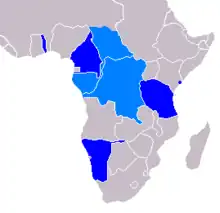.png.webp)
The Septemberprogramm (German: [zɛpˈtɛmbɐpʁoˌɡʁam], literally "September Program") was a memorandum authorized by Chancellor Theobald von Bethmann Hollweg of the German Empire at the beginning of World War I (1914–18). It was drafted on 9 September 1914 by the Chancellor's private secretary, Kurt Riezler, in preparation of peace negotiations at a time when Germany expected to defeat France quickly and decisively on the Western front. The territorial changes proposed in the Septemberprogramm included making a vassal state of Belgium, annexing Luxembourg and portions of France, expanding German colonies in Africa, and increasing German influence in Eastern Europe at the expense of the Russian Empire.
The Septemberprogramm gained great notoriety after it was discovered by historian Fritz Fischer, who wrote that it was based on the Lebensraum philosophy as well as the Drang nach Osten nationalist movement of the 19th century, which made territorial expansion Imperial Germany's primary motive for war.[1] This interpretation has been controversial. The modern consensus among historians is that it was more of a discussion document, written well after the start of the war, and not a formally adopted government policy.[2]
War goals

The Septemberprogramm was a list of possible goals for Germany to achieve in the war:[3][4]
- France should cede some northern territory, such as the iron-ore mines at Briey and possibly a coastal strip running from Dunkirk to Boulogne-sur-Mer, to Belgium or Germany.
- France should pay a war indemnity of 10 billion German Marks, with further payments to cover veterans' funds and to pay off all of Germany's existing national debt. This would prevent French rearmament for the next couple of decades, make the French economy dependent on Germany, and end trade between France and the British Empire.
- France would partially disarm by demolishing its northern forts.
- Belgium should become a vassal state and cede eastern parts and possibly Antwerp to Germany and give Germany military and naval bases.
- Luxembourg should be annexed and become a member state of the German Empire.
- Buffer states would be created in territory carved out of the western Russian Empire, such as Poland, Ukraine, Belarus, Finland, Lithuania, a Baltic state and possibly Georgia, all of which would remain under German sovereignty.[3]
- Germany would create a Mitteleuropa economic association, ostensibly egalitarian but actually dominated by Germany. Members would be France, Belgium, the Netherlands, Denmark, Austria-Hungary, the new buffer states, and possibly Italy, Sweden, and Norway.[4]
- The German colonial empire would be expanded. The German possessions in Africa would be enlarged to create a contiguous German colony across central Africa known as Mittelafrika, at the expense of the French and Belgian colonies. Presumably to leave open future negotiations with Britain, no British colonies were to be taken, but Britain's "intolerable hegemony" in world affairs was to end.
- The Netherlands should be brought into a closer relationship to Germany while avoiding any appearance of coercion.
Significance
The Septemberprogramm was based on suggestions from Germany's industrial, military, and political leadership.[5][2] However, since Germany did not win the war, it was never put into effect. As historian Raffael Scheck concluded, "The government, finally, never committed itself to anything. It had ordered the Septemberprogramm as an informal hearing in order to learn about the opinion of the economic and military elites."[2]
In the east, on the other hand, Germany and her allies did demand and achieve significant territorial and economic concessions from Russia in the Treaty of Brest-Litovsk and from Romania in the Treaty of Bucharest.[2] Both treaties were annulled with the Armistice of 11 November 1918 that ended the fighting in World War I.
References
- ↑ Fischer, Fritz (1967). Germany's Aims in the First World War (PDF). New York: W.W. Norton. pp. 98 ff. ISBN 978-0393097986.
- 1 2 3 4 Scheck, Raffael (2008). Germany, 1871–1945: A Concise History. Oxford: Berg. ISBN 9781845208172.
- 1 2 Tuchman, Barbara (1962). The Guns of August. New York: Macmillan Co. p. 321. ISBN 9780026203104.
- 1 2 "The September Memorandum (September 9, 1914)". German History in Documents and Images (GHDI). Retrieved 19 December 2022.
- ↑ Thompson, Wayne C. (1980). In the Eye of the Storm: Kurt Riezler and the Crises of Modern Germany. Iowa City: University of Iowa Press. pp. 98–99. ISBN 978-0-87745-094-8.
Further reading
- Thompson, Wayne C. (December 1978). "The September Program: Reflections on the Evidence". Central European History. 11 (4): 348–354. DOI: https://doi.org/10.1017/S0008938900018823
- Thompson, Wayne C. (1980). In the Eye of the Storm: Kurt Riezler and the Crises of Modern Germany. Iowa City: University of Iowa Press. ISBN 978-0-87745-094-8.
External links
- (in German) Full text of the Septemberprogramm (DeuFraMat = Deutsch-französische Materialien für den Geschichts- und Geographieunterricht (German-French Materials for Historical and Geographic Education))
- (in English) English translation of the Septemberprogramm. Retrieved on 2022-12-19.